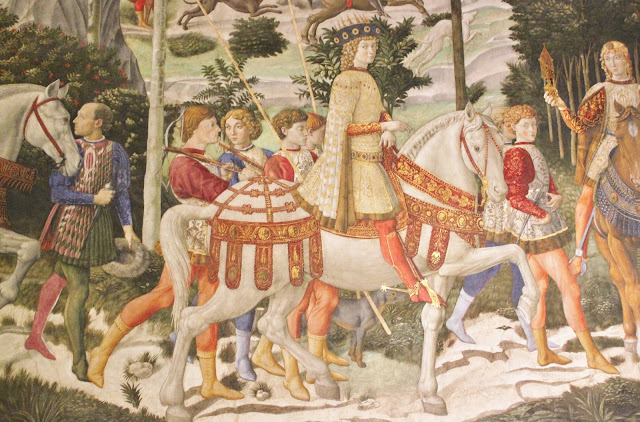The Magi Chapel in the Palazzo Medici-Riccardi.
Perhaps one of the greatest jewels of Western art, the Magi Chapel in the Palazzo Medici-Riccardi in Florence is famous for its cycle of frescoes by the Renaissance master Benozzo Gozzoli, painted in 1459-1461 for the Medici family, when they ruled over Florence. The chapel is located on the piano nobile of the palace, designed by Michelozzo. Benozzo Gozzoli, the greatest among Fra Angelico's followers painted this cycle over three walls: the Journey of the Magi to Bethelehem shows each of the Three Magi on their way to see the Nativity of Jesus. The religious theme was combined with depictions of several members of the great House of Medici and their allies, as well as some important people who arrived in town for the "Council of Florence” (1438-39) some decades earlier. On that occasion the Medici could boast to have facilitated the reconciliation between the Catholic and the Byzantine churches. It is also an interesting comparison of how the most refined people on earth at the time: the Florentines and the Byzantines admired and impressed each other.
In the apse, the sides walls are painted with saints and angels in adoration, where Gozzoli followed the style of his master, Fra Angelico. The angels are both adoring and singing to the Adoration altarpiece, acknowledging the solemnity of the the birth of Christ but also singing its glory.
The altarpiece, Filippo Lippi's Adoration of the Christ Child, is now in Berlin, replaced by a copy by a follower of the artist. It follows the theme of the rest of the chapel, as this is also set in a Renaissance almost magical wood. God the Father is pleased by his work, John the Baptist, give thanks for the birth of his mystical brother and the Virgin prays before the holy fruit of her womb.
There are also three narrow vertical fresco sections showing the shepherds of the nativity. The lively colors and detail of the frescoes are re-echoed by the precious mosaics of the pavement, the gilded ceiling and the wooden stalls designed by Giuliano da Sangallo. The woodwork is quite elaborate, in gives movement to the originally Gothic decoration in the way only the Renaissance can.
Gozzoli portrayed rich Tuscan landscapes, probably influenced by Early Netherlandish artists - perhaps via tapestries, an essential collectible item in Renaissance Florence.
There are also fascinating hunting and live nature scenes scattered through what is actually the main "plot". These were both common themes at the time for the decoration of a gentleman's palazzo or chapel. It would made one thing of Paolo Ucello's works. Whereas on one side these scenes can be brutal, they can also be quite gentle, like the birds bathing in the little pond.
Members of the Medici family and their entourage are shown riding in the foreground of the fresco on the east wall. Caspar, the youngest Magus, leads the procession on a white horse - this figure has often been taken for Lorenzo il Magnifico, who was born in 1449 and so was still a boy when the fresco was completed; he is more likely portrayed by another figure.
Closely following Caspar are the contemporary head of the family, Piero the Gouty, on a white horse and devout family founder Cosimo on a humble donkey. Then comes Sigismondo Pandolfo Malatesta and Galeazzo Maria Sforza, respectively lord of Rimini and Milan: they did not take part in the Council, but were guests of the Medici in Florence in the time the frescoes were executed.
A procession of illustrious Florentines follows, here are the humanists Marsilio Ficino and the Pulci brothers, the members of the Art Guilds and Benozzo himself. The painter looks out at the viewer and can be recognized for the scroll on his red hat, reading Opus Benotii.
Little Lorenzo il Magnifico is the boy directly below him with the distinctive snub nose; Lorenzo's elder brother Giuliano is next to him. The procession continues on the other wall: Bearded Balthasar, the middle Magus is riding another white horse. He is portrayed as Byzantine emperor John VIII Palaiologos.
It was once thought that the three pages behind him represented Piero's daughters, but were probably only secondary members of the family.
Melchior, the oldest Magi, rides on the west wall. Traditionally, his features have been read as those of Joseph, Patriarch of Constantinople, who died in Florence during the Council; but they could also be those of Sigismund, Holy Roman Emperor, who helped end the Great Schism by convoking the Council of Constance in 1414.
Like Cosimo, he is shown as a peacemaker riding on a donkey. He is preceded by a page dressed in blue with a leopard, on his horse.





















Comments
Post a Comment